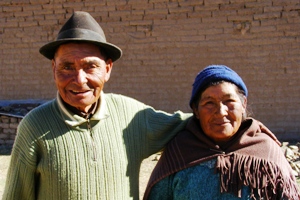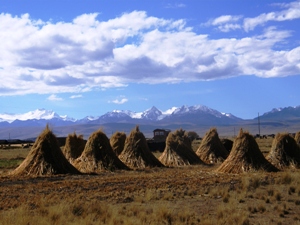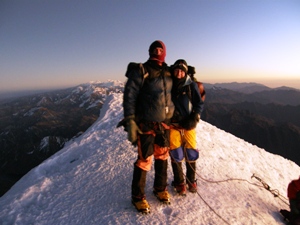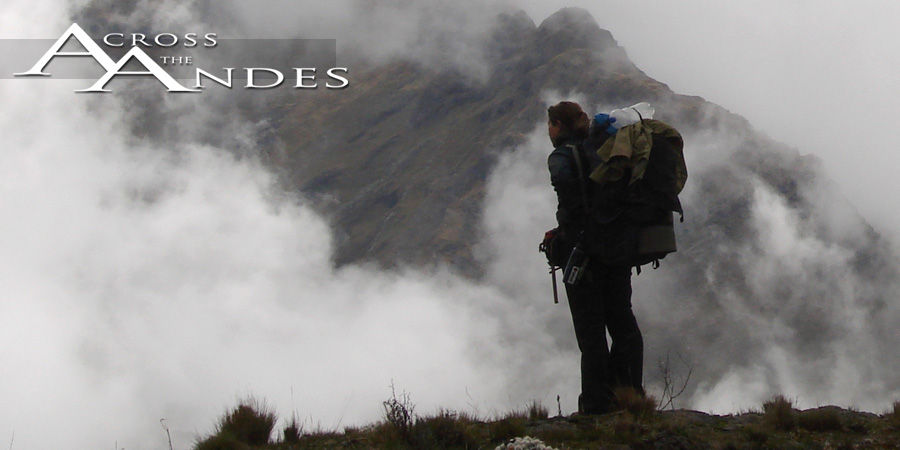Bolivian Navy Raided By Swan
By Deia Schlosberg
June 26, 2007

The train tracks took us right out of Oruro, though we
were more than ready to finally get off of them. It would be a few more
days, however, and once our route parted from the rails, our flatness
continued nonetheless. Soon, in the distance to the north, we caught
our first views of the Cordillera Real, Bolivia's portion of the
breathtaking breed of Andean peaks. Still a week away, and so enormous
that we could see their snowy peaks over the local ridges. My first
view of Illimani was as glorious as any sight to date. For several more
days, we were teased with walking alongside the range, but still along
the perfectly flat 12-13,000 ft. altiplano. Our only deviation was a
spur-of-the-moment, frustration-based two-day detour when we beelined
it over a nearby ridge to get ourselves a fix of topography and only
add perhaps a few extra hours by doing so. We ended up getting way more
than topography from the decision. Our first night back in the hills,
as we were walking after dark toward a small town that would perhaps
have a soccer field for some flat-ish camping, we were intercepted by a
man named Alfredo, walking up the hill toward his parents' house, who
insisted we come with him and stay with the family. He and his siblings
and respective families had come back to the country from La Paz to
help his parents with the harvest. We had unknowingly ended up in the
middle of a family reunion of sorts, which became evident as we walked
up to the house and were greeted by a small crowd of lovely folks and a
fire. We all went into the one bedroom/living room/dining room and had
a great conversation with everyone and felt very welcomed. When we went
to sleep on a few very comfortable sheep skins, I didn't think too much
about where they had come from, let alone the manner in which they were
acquired. Early the next morning, though, I became enlightened. We
heard an alarm go off long before the sun came up, and the sleepers
inside the large room that we were just outside of began to stir. It
was not long before a fire was going outside in the cooking ring and we
were drinking tea and eating bread with everyone. Before I was done
with my roll, Alfredo and his father were on the way out the door
saying if anyone wanted to help kill the sheep, come now. Gregg was
outside with them before I could look up. I stayed inside to finish
breakfast for a few minutes, and walked outside just in time to see the
decapitation. It went quickly. What then ensued was a fascinating
anatomy lesson and a reminder of how distanced we usually are from our
food. We learned in about half an hour how to skin and gut a sheep and
salvage every possible part of it. Carmen, the very dynamic grandmother
of the family, ran into the courtyard to collect two sections of rib
for the fire, as the rest of the meal was well on its way and the meat
was slowing down the process. I thought it was excellent that even the
elementary-aged kids were helping out with the sheep, holding the legs
out of the way and running various parts out to the fire to be used in
the soup; they will forever have an appreciation of meat as nourishment
from another life and not just as a product on a shelf. The rest of the
morning was somewhat of a frenzy of eating the exceptionally delicious
and fresh food around the fire--sheep, potatoes and soup--and preparing
the burros and some goods, including a decent part of the sheep, for
town. But before we all headed down the road, a family photo was
assembled in the field, including the largest bull and the youngest
donkey and cow. And to the familia, ¡Gracias de nuevo un millon veces
por su cariñosidad!
None of the rest of walk until the Cordillera Real was nearly as notable as our only true Bolivian homestay. There was, of course, the accidental happening upon a group of mourners that was slightly awkward. A group of people sitting around in a circle with lots of food and drinks, beckoning us over to them and inviting us to share a meal made us ask what the party was for. It was not a party. Oops. But we learned a few Aymará words and had a nice conversation with a few of the members of the family. They had been at it for a week, which explained why there was no noticeable cloud of grief hanging over the circle and why the gathering could be mistaken for a fiesta. To further awkwardify the event, the head authority figure there asked us, since we were Americans and were rich, if we could give some money to the family to help out. We would have been happy to simply give a small gift, as everyone else had probably done, to a grieving family, but we also wanted to clarify that not all Americans are rich and certainly not like those shown on TV. It's difficult to clear up prejudices without appearing cheap and like a liar. Sometimes we tell people that we don't have any extra money and just get laughed at because many people think 90210 and Desperate Housewives is the only way people live in the U.S. But others listen to what we say and give it a moment of thought and may even believe us, in the face of all American media, so it seems. The authority guy at this event clearly didn't hear us for a second, but we gave a small donation and hoped that the family itself understood.

A night hike revealed La Paz to us long before we
otherwise would have seen it. It appeared as a huge strip of light
across the high valley. La Paz and Lake Titicaca have been anticipated
for ages as our half-way mark, and so cresting that hill in the dark
and realizing what we were looking at was big. A few more days of
walking through fields in the middle of harvest time with snow capped
mountains as the backdrop brought us to Batallas, a town on the shore
of the Lake where we would share a beer in the town square at sunset
and get teary and realize that we still have as much experience left as
we've already had down here. Inconceivable, really. Half of what I've
already done would be enough to significantly affect my life, and now
to think of doubling it ... hard to imagine, but good stuff.
The whole last section until halfway, we had been tossing around the idea of doing another peak near La Paz to celebrate, but we would have to make it there before June 15th to keep to our season-dictated schedule. With memories of Nevado Pisco in our heads, we pushed to get there by the 11th, averaging 23 miles a day. La Paz is an impressive city, built, just as it's described, in a huge natural bowl with buildings climbing steeply up the sides and a painting-like backdrop of the cordillera. Once there, we talked to some mountain guides and made arrangements to climb Huyna Potosi, a 6,088m (19,974 ft.) peak. I was extremely excited to experience altitudes that I never had before and see that eerie and magical high-alpine sunrise once again. Not, however, looking forward to the bodily sensations of the altitude--the nausea and headache and sleepiness that I felt last time we were at an even lesser elevation. But the good far outweighed the bad in my mind, and so my excitement outweighed my anxiety. We took a car with Isaak, one of our guides, up a winding dirt road toward the refugio, getting increasingly spectacular glances of our mountain with every turn. We were to meet Andres,our other guide, there, as he was just coming down from that morning's summit effort. He was born just up the range a bit, in a small town near Illimani, and has been guiding in the mountains for seven years. A 20,000 ft.peak to him is a stroll, which is why he can do it three times in a week, including the lack of sleep that goes along with the alpine (12:30-3:00 a.m.) starts. After arriving and finishing the steep hike up to the high camp, we had some time to rest and talk a bit more. Gregg interviewed Andres about his observations of the mountain over the past ten years (as long as he has been climbing it), and I was astonished to hear what he had to say. He showed us where the glacier had extended to ten years ago, very far below us, and said that everyone expected that the entire glacier would be gone in five more years if the same rate of recession continued, though the same rate is a hopeful one. There are several refugios (climbers' shelters or camps) along the initial hike up to high camp, as they were built at the base of the glacier, and the base of the glacier has kept moving further up the mountain. Needless to say, all of that knowledge notably changed my experience of the climb. After a few restless hours of sleep, we woke up at 1:30 and put on all of our layers of gear: long underwear, mid-layers of fleece, down jacket, waterproof pants and jackets, balaclava and hat, plastic mountaineering boots, gaiters, harness, glove liners and gloves. We had some tea and a snack outside Andres and Isaak's tent and walked over to the glacier to put on our crampons and rope-up. The air was cool but not too cold. There was no wind and no clouds in the sky; all the stars and some occasional meteors were visible as we ascended. Absolutely perfect conditions. There were two other parties on the mountain, so we could also see the small spots of headlamp beams further up the route as well as following us up. The only sound was of our crampons digging into the packed snow. We made steady progress and were soon at the elevation we turned around at on Cotopaxi. The climb was going faster and easier than either of us expected, and neither of us felt any of the anticipated negative effects. Another hour and we were at our Pisco height, still cruising up, still feeling well. We had made it up the first technical section easily, using our ice picks to aid us up a fairly steep part. The only other real challenge was the final wall before the summit:150 vertical meters at about 55-60 degrees, and the altitude beyond our range of experience. Gregg and Andres moved quicker up the wall than Isaak and I. Digging the ice pick in as an anchor for every step, and every step being a kicking-in of the crampons to the snowpack is hard work in little oxygen. But I felt secure, and I felt strong, and I was getting closer to the summit every second. As I neared the top, I tuned around to see the very beginnings of sunrise behind me, a blue and orange band separating the dark sky from the dark altiplano we had walked over for the past week. Looking up I saw the still lights of Gregg and Andres. I thought they were resting and waiting for us before walking up the final bit to the summit. When I got close enough to see Gregg's face, however, I realized that we were already there. I stumbled quickly up the last few steps and collapsed next to Gregg out of happiness, out of accomplishment, out of awe from the beauty that was lighting up 360 degrees of earth around me as the sun broke out from the horizon at seemingly the same instant that I arrived on the tiny ridge. Here, there was a very cold wind. Always the time right around sunrise seems to be bitterly cold. We took a few happy, blurry pictures with our numb hands, turned ourselves around a few times on the 4 by 10 ft. piece of mountain that was the top, and got ready to repel back down. Our guides had set up the anchor while we were soaking up the moment. I would like to become more knowledgeable in alpine anchor systems, but I think I'll need to do enough peaks that the excitement and joy can subside enough in our small window of opportunity before it gets too cold to pay attention to something other than the view. We lowered ourselves through the alpine-glow and walked down through the beautiful and foreign environment that we had just passed through without seeing. Layers of glacier, like tree-rings, showing the accumulation of the years, 30 ft.icecles, spines of packed snow dancing up from the slope, crevasses in different stages of formation, caverns glowing blue from inside--all so magical and so rarely seen, and all vanishing. All quickly changing and by the time I can save up enough money after this trip to make it back to Bolivia someday, they will be gone. And once that happens, all of the communities along the rivers that are glacial runoff, including La Paz, a city of one million people, will be devastated, at least until an alternative comes along. I am luckier than I know to be here now.

We were not done with our diversions after the climb, however. We spent a few spectacular days trekking in the Cordillera Real, along a course that didn't necessarily get us any farther along on our route, but gave us some of the most phenomenal views of the trip so far. And we couldn't hike from Santiago to Titicaca and not visit the Island of the Sun in the lake, the origin of humankind according to the Aymara and Inca. Turns out we probably could have missed it, being completely touristed-out, so much so that it didn't feel authentic, but it was a beautiful place, and we did meet and hang out with some very cool other travelers. Finally, we sit in Puno, Peru, ready to continue with the walk north. I already miss Bolivia, but in doing some route research today, I was reminded of how spectacular Peru is as well. I am excited to learn more about the historically monstrous areas we are now heading toward, Machupicchu being the most famous, though the whole region is thick with ruins and trails and stories.
Special thanks this time to Andrea Reger, and to Kelly for East of Eden. Love to family and friends. Be in touch







